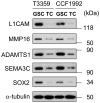Elevated invasive potential of glioblastoma stem cells
- PMID: 21371437
- PMCID: PMC3065536
- DOI: 10.1016/j.bbrc.2011.02.123
Elevated invasive potential of glioblastoma stem cells
Abstract
Glioblastomas (GBMs) are the most lethal and common types of primary brain tumors. The hallmark of GBMs is their highly infiltrative nature. The cellular and molecular mechanisms underlying the aggressive cancer invasion in GBMs are poorly understood. GBM displays remarkable cellular heterogeneity and hierarchy containing self-renewing glioblastoma stem cells (GSCs). Whether GSCs are more invasive than non-stem tumor cells and contribute to the invasive phenotype in GBMs has not been determined. Here we provide experimental evidence supporting that GSCs derived from GBM surgical specimens or xenografts display greater invasive potential in vitro and in vivo than matched non-stem tumor cells. Furthermore, we identified several invasion-associated proteins that were differentially expressed in GSCs relative to non-stem tumor cells. One of such proteins is L1CAM, a cell surface molecule shown to be critical to maintain GSC tumorigenic potential in our previous study. Immunohistochemical staining showed that L1CAM is highly expressed in a population of cancer cells in the invasive fronts of primary GBMs. Collectively, these data demonstrate the invasive nature of GSCs, suggesting that disrupting GSCs through a specific target such as L1CAM may reduce GBM cancer invasion and tumor recurrence.
Copyright © 2011 Elsevier Inc. All rights reserved.
Figures




References
-
- Furnari FB, Fenton T, Bachoo RM, Mukasa A, Stommel JM, Stegh A, Hahn WC, Ligon KL, Louis DN, Brennan C, Chin L, DePinho RA, Cavenee WK. Malignant astrocytic glioma: Genetics, biology, and paths to treatment. Genes and Development. 2007;21:2683–2710. - PubMed
-
- Wen PY, Kesari S. Malignant gliomas in adults. New England Journal of Medicine. 2008;359:492–507. - PubMed
-
- Stupp R, Mason WP, Van Den Bent MJ, Weller M, Fisher B, Taphoorn MJB, Belanger K, Brandes AA, Marosi C, Bogdahn U, Curschmann J, Janzer RC, Ludwin SK, Gorlia T, Allgeier A, Lacombe D, Cairncross JG, Eisenhauer E, Mirimanoff RO. Radiotherapy plus concomitant and adjuvant temozolomide for glioblastoma. New England Journal of Medicine. 2005;352:987–996. - PubMed
-
- Park DM, Sathornsumetee S, Rich JN. Medical oncology: Treatment and management of malignant gliomas. Nature Reviews Clinical Oncology. 2010;7:75–77. - PubMed
Publication types
MeSH terms
Substances
Grants and funding
LinkOut - more resources
Full Text Sources
Other Literature Sources
Medical
Research Materials

